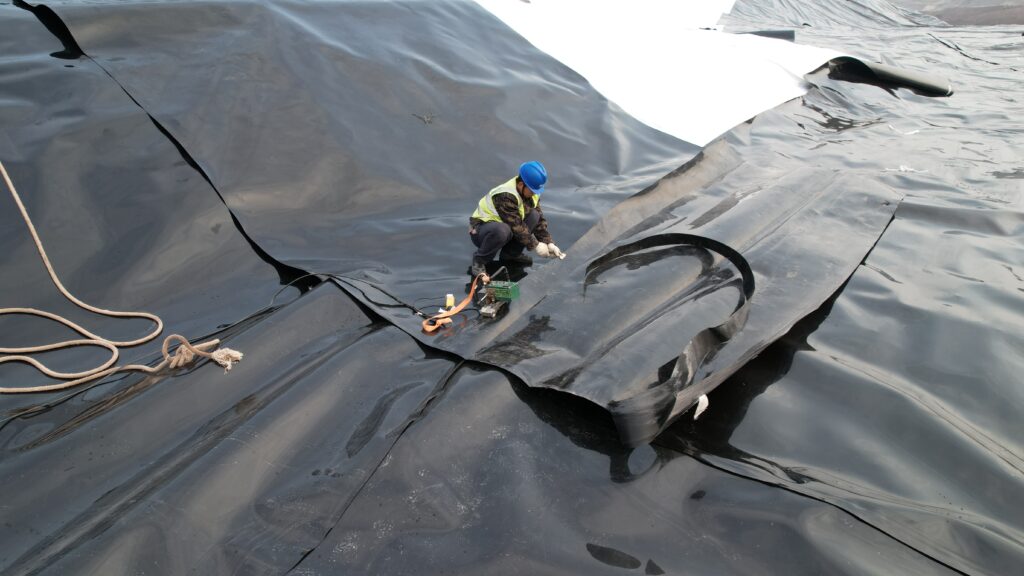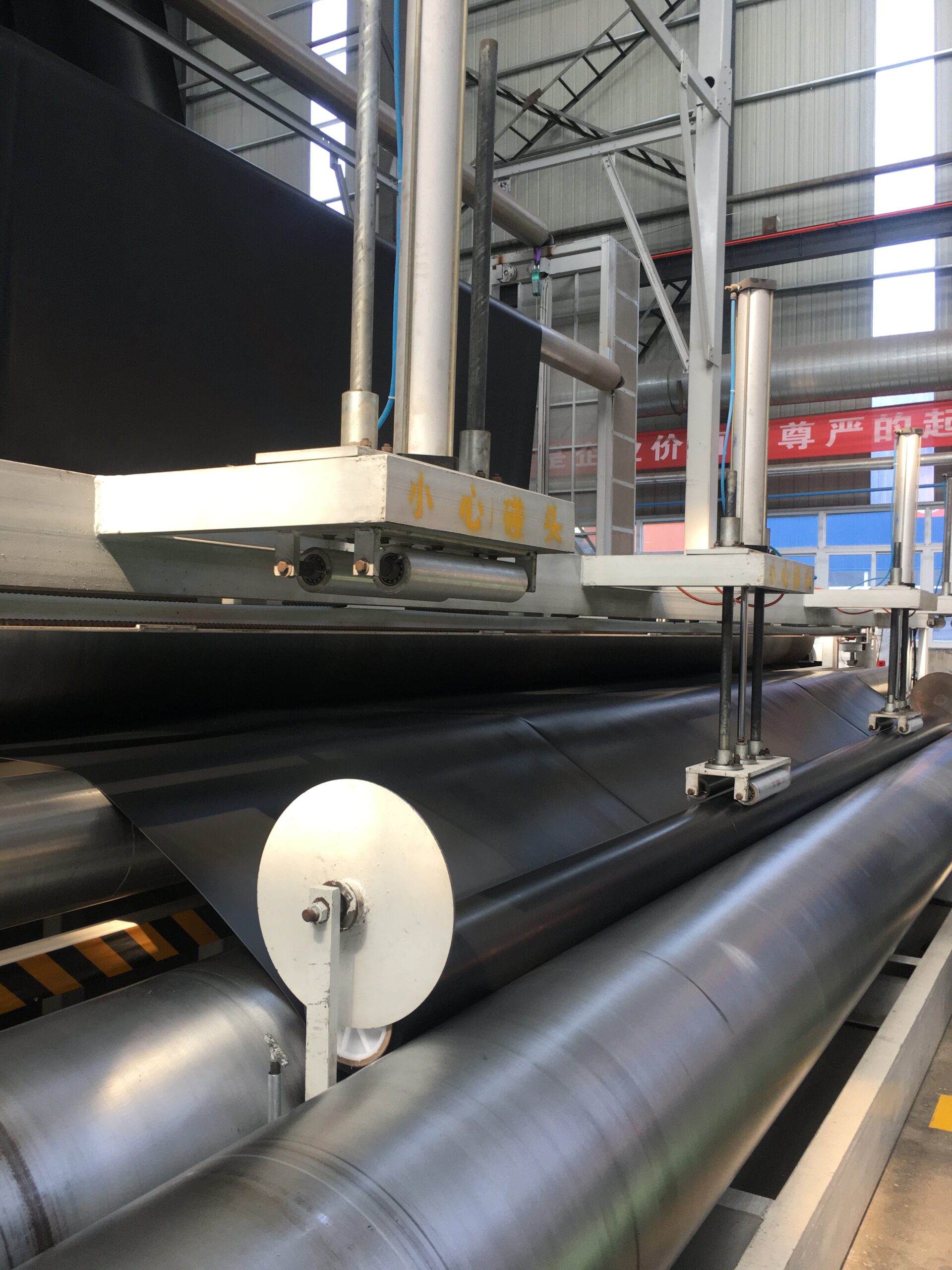What quality tests do HDPE geomembranes need to do?
High-Density Polyethylene (HDPE) geomembranes are subjected to various quality tests to ensure their effectiveness and durability in containment applications such as landfill liners, pond liners, and water storage reservoirs. Some common quality tests for HDPE geomembranes include:
Thickness Measurement: HDPE geomembranes must meet specific thickness requirements to provide the necessary barrier properties. Thickness is typically measured using calibrated tools at various points across the geomembrane.
Tensile Strength: Tensile strength tests evaluate the material’s ability to withstand stretching or pulling forces without breaking. This test helps assess the geomembrane’s structural integrity and resistance to tearing.
Tear Resistance: Tear resistance tests measure the force required to propagate a tear in the geomembrane material. This is crucial for evaluating the material’s ability to resist punctures and damage during installation and service.
Puncture Resistance: Puncture resistance tests assess the geomembrane’s ability to resist penetration by sharp objects, such as rocks or roots, which helps prevent leaks in containment applications.
Seam Strength: In applications where multiple geomembrane panels are seamed together, seam strength tests ensure that the joints are as strong as the geomembrane itself, preventing leaks at seam locations.
Chemical Resistance: HDPE geomembranes are often used to contain hazardous substances, so chemical resistance tests assess their resistance to various chemicals, acids, and alkalis commonly found in industrial and environmental settings.
UV Resistance: Exposure to ultraviolet (UV) radiation can degrade geomembrane materials over time, leading to loss of mechanical properties and reduced service life. UV resistance tests evaluate the material’s ability to withstand UV exposure without significant deterioration.
Oxidative Stability: HDPE geomembranes may undergo oxidative degradation over time, particularly in environments with high temperatures or exposure to oxygen. Oxidative stability tests measure the material’s resistance to degradation caused by oxidation.
Permeability Testing: Permeability tests determine the geomembrane’s ability to prevent the passage of liquids or gases through its thickness, ensuring effective containment of liquids or gases in containment applications.
Hydraulic Properties: Hydraulic properties such as hydraulic conductivity and flow rate are important for evaluating the geomembrane’s performance in applications where hydraulic flow is a concern, such as in landfill liners or pond liners.
Dimensional Stability: Dimensional stability tests assess the geomembrane’s ability to maintain its original dimensions under various environmental conditions, including temperature fluctuations and exposure to moisture.
These tests help ensure that HDPE geomembranes meet industry standards and regulatory requirements for quality, performance, and environmental protection in various containment applications.

HDPE geomembrane tension test
The tension test for HDPE geomembranes is a critical quality control measure that assesses the material’s tensile strength, elongation, and deformation behavior under applied load. Here’s how the tension test is typically conducted for HDPE geomembranes:
Sample Preparation: Samples of the HDPE geomembrane material are prepared according to relevant standards or specifications. The samples are typically cut into strips of specified dimensions, with consideration given to the directionality of the material if applicable (e.g., machine direction, transverse direction).
Conditioning: The samples may be conditioned to standardized environmental conditions, such as temperature and humidity, to ensure consistent testing conditions and accurate results.
Test Setup: The prepared samples are clamped securely in a universal testing machine (UTM) or tensile testing apparatus. Care is taken to ensure that the clamping mechanism does not damage the specimen or introduce stress concentrations.
Load Application: A controlled tensile load is applied to the specimen at a constant rate, typically expressed in units of force (e.g., Newtons or pounds-force) per unit of cross-sectional area (e.g., square millimeters or square inches). The rate of loading is often specified in relevant standards or test methods.
Data Collection: During the test, data such as load (force) and elongation (strain) are continuously recorded or monitored. This data allows for the determination of the stress-strain behavior of the material, including its tensile strength, elongation at break, and modulus of elasticity.
Analysis: Once the test is complete, the recorded data is analyzed to determine key mechanical properties of the HDPE geomembrane, including:
Tensile Strength: The maximum load sustained by the specimen before failure, expressed in units of force per unit of cross-sectional area (e.g., megapascals or pounds per square inch).
Elongation at Break: The percentage increase in length of the specimen at the point of failure compared to its original length.
Modulus of Elasticity: A measure of the material’s stiffness or resistance to deformation under tensile loading, calculated from the initial linear portion of the stress-strain curve.
Reporting: The results of the tension test, including mechanical properties and any relevant observations, are documented in a test report or quality control record. These results may be compared against specified requirements or industry standards to assess compliance and quality assurance.
By conducting tension tests on HDPE geomembrane samples, manufacturers and quality control personnel can ensure that the material meets performance specifications and regulatory requirements for applications such as landfill liners, pond liners, and environmental containment systems.

HDPE geomembrane puncture test
The puncture test for HDPE geomembranes is crucial for assessing the material’s resistance to penetration by sharp objects, such as rocks, roots, or other debris, which could compromise its integrity and lead to leaks in containment applications. Here’s an overview of how the puncture test is typically conducted for HDPE geomembranes:
Sample Preparation: Specimens of the HDPE geomembrane material are prepared according to relevant standards or specifications. These specimens are typically circular or rectangular in shape and have standardized dimensions, thickness, and surface conditions.
Puncture Apparatus: A puncture test apparatus is used to apply a controlled force to a sharp or pointed indenter, simulating the impact of a sharp object on the geomembrane surface. The indenter may have a standardized shape, such as a conical or hemispherical tip, and is typically made from a rigid material such as steel.
Test Setup: The prepared specimen is securely clamped or mounted in a fixture to prevent movement during testing. The puncture apparatus is positioned directly above the specimen, with the indenter aligned perpendicular to the surface of the geomembrane.
Puncture Application: A controlled force is applied to the indenter, causing it to penetrate the geomembrane specimen at a constant rate. The force may be applied manually or using a mechanical or hydraulic system capable of precise force control. The force applied is typically specified in relevant standards or test methods.
Observation and Measurement: During the test, observations are made of the puncture process, including the initiation of damage, propagation of the puncture, and any visible signs of failure such as tearing or stretching of the geomembrane material. The maximum force required to puncture the geomembrane is recorded, along with any relevant measurements of puncture depth or diameter.
Analysis: Once the test is complete, the recorded data is analyzed to determine the puncture resistance of the HDPE geomembrane material. This may include calculating metrics such as puncture strength (the maximum force sustained before failure) and puncture energy (the energy absorbed by the geomembrane during the puncture process).
Reporting: The results of the puncture test, including the maximum force applied, puncture depth or diameter, and any relevant observations or comments, are documented in a test report or quality control record. These results can be compared against specified requirements or industry standards to assess compliance and ensure the quality and integrity of the geomembrane material.
By conducting puncture tests on HDPE geomembrane samples, manufacturers and quality control personnel can evaluate the material’s resistance to puncture and assess its suitability for use in containment applications where puncture resistance is critical.
Author
-

Founded in 2002, Tinhy's team focuses on the manufacturing, marketing, installation, application and research and development of geosynthetic materials.
View all posts




